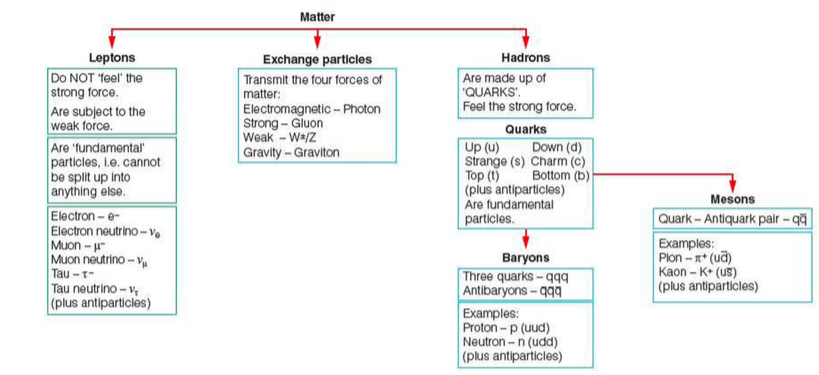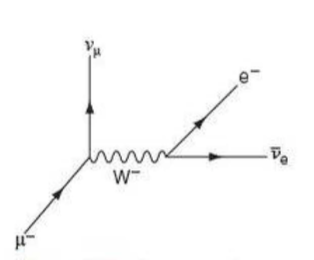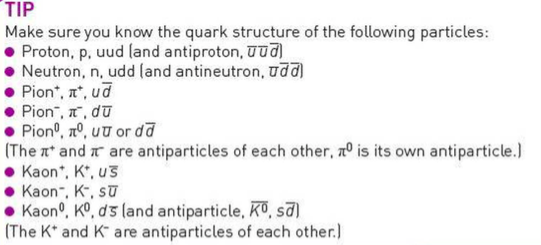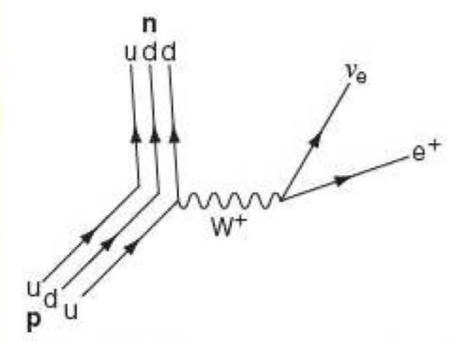Classification of Particles
Introduction
⇒ Over the years the fundamental particles have been arranged into three distinct groups: leptons, hadrons, and exchange particles

Leptons
Overview
⇒ Other than the exchange particles, there are two main groups of matter: leptons and hadrons
⇒ Leptons are fundamental particles (in that they cannot be sub-divided into smaller particles)
⇒ Leptons include the electron, the muon, and the tau, all of their neutrinos (the electron neutrino, muon neutrino, and tau neutrino), and all of their corresponding antiparticles (12 in total)
- For example, there is an electron, electron neutrino, and a positron (the antiparticle of the electron)
⇒ Leptons are subject to the weak force and not the strong force
⇒ All leptons have a quantum number known as a lepton number (L), which distinguishes them as leptons
- All leptons (such as the electron) have a lepton number of L = +1, but a charge Q = -1(e) or 0
- All the antileptons (such as the positron) have a lepton number of L = -1, but a charge Q = +1(e) or 0
- All other non-leptonic particles have a lepton number of L = 0
⇒ In any particle interaction the law of conservation of lepton number must be preserved i.e. the total number of leptons before an interaction must be equal to the total number of leptons after an interaction
⇒ For example, see how the lepton number is preserved in β- decay, below:

Muon decay
⇒ Muons are unstable particles and have a mass 200 times greater than that of an electron
⇒ Muons have an unusually long lifetime, of about 2.2 microseconds - see the lifetime of other particles below:

⇒ All muons decay through weak interaction (as leptons are only subject to the weak force) into three particles: an electron (or positron) and two neutrinos
⇒ The decay equations for the muon and antimuon can be seen below:

⇒ A Feynman Diagram for muon decay can also be seen here:

Hadrons
Overview
⇒ As they are made up of quarks, they are subject to strong nuclear interaction
⇒ They are made up of baryons and mesons
⇒ Baryons (such as protons, neutrons, and their antiparticles) are made up of three quarks (or three antiquarks)
⇒ The proton has two up quarks and a down quark, which means it has a total charge of +1e
⇒ The antiproton has two up antiquarks and a down antiquark, which means it has a total charge of -1e
- Remember, the antiquarks have the opposite charge to their corresponding quarks
⇒ Mesons (such as the pion and kaon, and their antiparticles) consist of a quark-antiquark pair
Quark Structure of Hadrons

Baryons
⇒ There are six quarks and baryons are made up of a combination of three of them, so there are many different possible baryons (e.g. protons and neutrons)
⇒ Other baryons (especially containing heavier quarks) have only really been observed at high-energies (e.g. inside particle accelerators)
⇒ Each baryon has a corresponding antibaryon, which is constructed of the corresponding antiquarks
- For example the sigma baryon (Σ+) is made of two up quarks and a strange quark. However, the antisigma baryon is made of two up antiquarks and one strange antiquark
⇒ Protons are stable, abundant, and have an extremely long lifetime. Neutrons are also pretty stable.
⇒ However, most baryons have an extremely short lifetime
⇒ All baryons also have a baryon quantum number
- Baryons have a baryon number of B = +1, antibaryons have a baryon number of B = -1, and all other non-baryons have a baryon number of B = 0
- Like the lepton number, the baryon number is also conserved in particle interaction
⇒ As quarks and antiquarks make up baryons they also have a baryon number:
- Quarks have a baryon number of B = + 1/3, antiquarks have a baryon number of B = - 1/3
- So protons, which have a quarks makeup of uud, are constructed of three B= + 1/3 quarks, giving them a total baryon number of B = 1
Feynman Diagrams
⇒ Feynman Diagrams can also be drawn showing the quarks within the composite particles i.e. we can see what happens to the quarks inside the protons and neutrons during an interaction
⇒ This is a Feynman Diagram, therefore, for β- decay:

⇒ Here you can see that the down quark decays into a W- exchange particle and an up quark
⇒ And also see what it looks like for β+ (positron) decay:

Mesons
⇒ Remember gluons are the force carriers of the strong force between quarks
- E.g. they carry the strong force beteen the three quarks in baryons (such as protons and neutrons) and the two quarks in mesons (such as pions)
⇒ But mesons mediate the residual strong force which binds protons and neutrons together to form a nucleus
- In essence, two nucleons come close enough together so that the quarks of nucleon one can feel the quarks of nucleon too (and this 'feeling', of course, is just a manifestation of energy)
- Once the interaction between those constituent quarks is 'strong enough' a quark-antiquark pair (i.e. a pion) will be created out of the energy (since energy and mass are equivalent) and will mediate the strong force between the nucleons
⇒ Mesons are made up of quark-antiquark pairs
⇒ Because there are 6 quarks and 6 antiquarks, there are many different types of meson
⇒ Most mesons are only really observed where there is high enough energy (e.g. particle accelerators)
⇒ Mesons have a lepton number (L = 0, as they are not leptons) and a baryon number (B = 0, as they are not baryons)
Pions
⇒ There are three types of pion, made from up and down quarks (and their corresponding antiparticles):

⇒ The π+/π- are each other's antiparticles and the π0 is its own antiparticle
⇒ Pions are unstable and decay rapidly
⇒ The π+/π- decay into muons and muon neutrinos via the weak interaction:


⇒ A π0 decays into two gamma rays
Kaons
⇒ This is the other common meson produced by cosmic ray interaction
⇒ A kaon contains a strange quark or a strange antiquark (with charge -1/3 e)
⇒ The term strangeness was coined to describe the strange behaviour of particles that were always produced in pairs by the strong interaction but decay by the weak interaction
⇒ There are four kinds of kaons:

⇒ As you can see, the strange quark has strangeness -1 and the anti-strange quark has strangeness +1
⇒ So kaons are produced through pair-production through strong interaction, and strangeness is conserved
- For example, when two protons collide, a K- and K+ pair is produced, and the strangeness is conserved:

⇒ Kaons are also unstable and decay via the weak interaction - they have lifetimes of about 10-8s to 10-8s
⇒ Charged Kaons can decay in several ways:

⇒ As you can see, when a kaon decays, there is no strange quark so strangeness is not conserved
- So although strangeness is conserved during kaon pair-production, it is not conserved when kaon's decay
Extra
⇒ Also see our notes on: